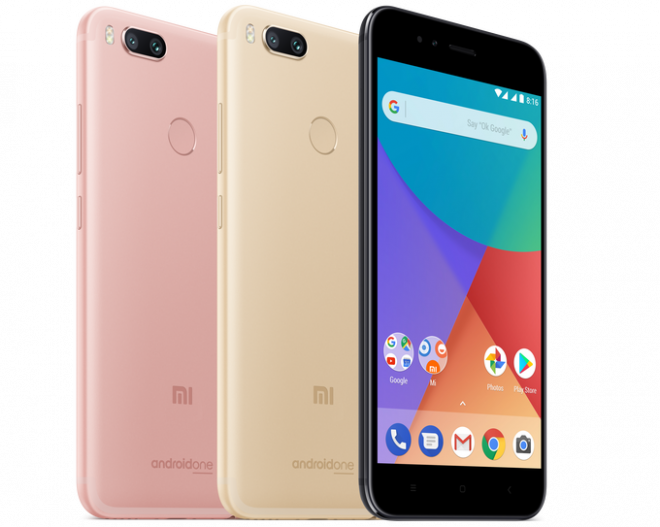
Xiaomi surprised the tech world earlier this week by launching its Mi A1 in India. The new smartphone is the company's very first device based on Android One -- a standard created by Google to offer pure Android experience. Despite being a part of the standardised platform, the latest champion is a distinct option in its Mi family as well as the entire Android One range. But how would it help the Android maker to bring another major success to the smartphone market? Also, in what ways, the new move would benefit Xiaomi?
"We're extending our commitment to Android One by working with more partners to build phones that run a software experience designed by Google," writes James Rosenberg, vice president of business and operations, Android and Google Play, in a blog post.
The extension of Android One brings a couple of significant changes to its original model that was piloted in India back in September 2014. Firstly, Xiaomi's Mi A1 is not as affordable as the first range of Android One handsets that included the Karbonn Sparkle V, Micromax Canvas A1 and Spice Dream UNO at a price under Rs. 6,000 (approximately S$126). The smartphone has been priced around the S$309 mark.
Secondly, the Mi A1 doesn't have as inferior specifications as the original Android One lineup. The smartphone has a 5.5-inch 1080p display, 4GB of RAM, 64GB flash storage, USB-C port and a metal body with 2.5D Corning Gorilla glass panel on the front. Plus, it is powered by Qualcomm's Snapdragon 625 processor and sports a dual-camera setup with two 12-megapixel sensors.
Stock experience as the prime focus

Analysts believe that the new tie-up between Google and Xiaomi is primarily aimed to help the former bring stock Android experience to the masses. The stock experience also comes with offerings such as Google Assistant and Google Photos integration. "If we look at the broader play by Google, it seems to be moving in the direction of offering stock experience on more and more handsets," says Kiranjeet Kaur, senior research manager, IDC Asia Pacific.
Also read: Alexa befriends Cortana to fight against Google Assistant, Siri
Kaur tells IBTimes SG that the SundarPichai-led team is planning to bring the vanilla Android to a wider range that includes the legacy Nexus phones, original low-end Android One handsets, premium Pixel flagships and the latest Android One devices. Parv Sharma of Counterpoint Research believes that the newest move is mainly targeting at users upgrading smartphones in the mid-range segment.
"With the Mi A1, Google aims to target users upgrading in the mid segment, especially the ones in emerging markets where the same segment is growing fast," Sharma, who is a research associate at Hong Kong-based Counterpoint Research, told IBTimes SG.
Fixes issue of fragmentation
Unlike Apple's iOS that has a unified presence across all the active iPhones and iPads, Android has so far been fragmented in the market. The Nougat version, which is yet to be replaced by the newly released Android Oreo, holds 13.5 percent of the total Android market, while 2015's Marshmallow variant is leading with 32.3 percent, as per the recent activations data revealed by Google's dashboard. This shows a lag that is planned to be fulfilled -- at least to some extent -- with Xiaomi's Android One smartphone.
"Fixing fragmentation will help Google to gain direct control of Android user base and drive more stickiness with timely latest features especially when software differentiation is likely to gain more popularity than hardware distinction for smartphones in short to medium term," Sharma asserts.
A large number of Android OEMs are deploying customisations on top of pure Android. This widens the fragmentation.
Until now, Xiaomi is also among the top vendors opting customised Android. The Chinese company has its proprietary MIUI skin that has over 170 million users worldwide. The custom ROM supports a range of handsets -- even includes compatibility with devices from OnePlus, Samsung and Sony among others. However, with the Mi A1, the Beijing-headquartered company has abandoned its MIUI and preferred natural experience that comes directly from the Android Open Source Project (AOSP).
Also read: Armed with Android Oreo, Google takes aim at bloatware
The reason for leaving the proprietary skin is apparently to provide frequent updates to the new smartphone that are being driven directly by Google. It would help Xiaomi to enhance its brand in countries like India where it often faces criticism for opting Chinese customisations that lead to some state-level vulnerabilities. Similarly, the move is expected to give Google a chance to give frequent security updates to more Android devices.
"The bigger issue for Google is not the customisation that each OEM does on top of Android but that the operating systems are not frequently upgraded and don't receive the latest security patches, and it is not in the hands of Google," says Kaur of IDC.
With Xiaomi aboard, other competing young players are also likely to join hands with Google in the coming months to take the Android One come back to new levels. The Android maker has this time even take a softer stance and allowed Xiaomi to add its custom camera enhancements on the new device to support its dual-camera system. "Google may follow this approach for other OEMs too, so they have their point of differentiation here," Kaur noted.
Expansion to 40 global markets
The original Android One programme had helped Google to bring its pure experience to 20 countries by partnering with more than 18 different OEMs. However, as Sharma of Counterpoint Research highlights, Xiaomi's sole partnership will directly help Google to reach over 40 countries around the globe, including Singapore as well as many European and American markets. "It is a win-win for both the companies," he concluded.
The success of the Mi A1 launch will be determined by its first sale that is scheduled for September 12. Nevertheless, the handset has catapulted Xiaomi back to the international headlines and made Google's Android One alive once again.









